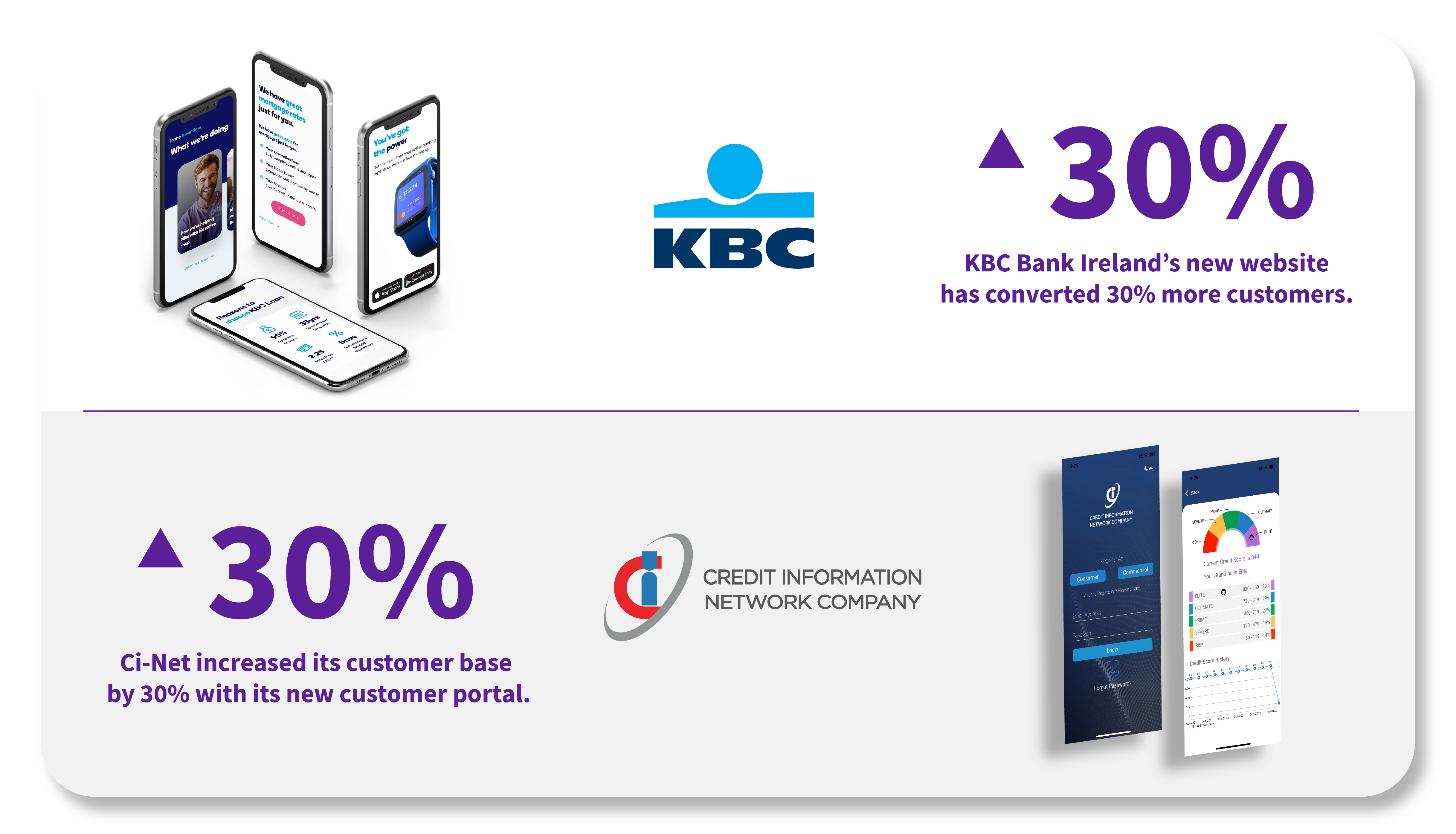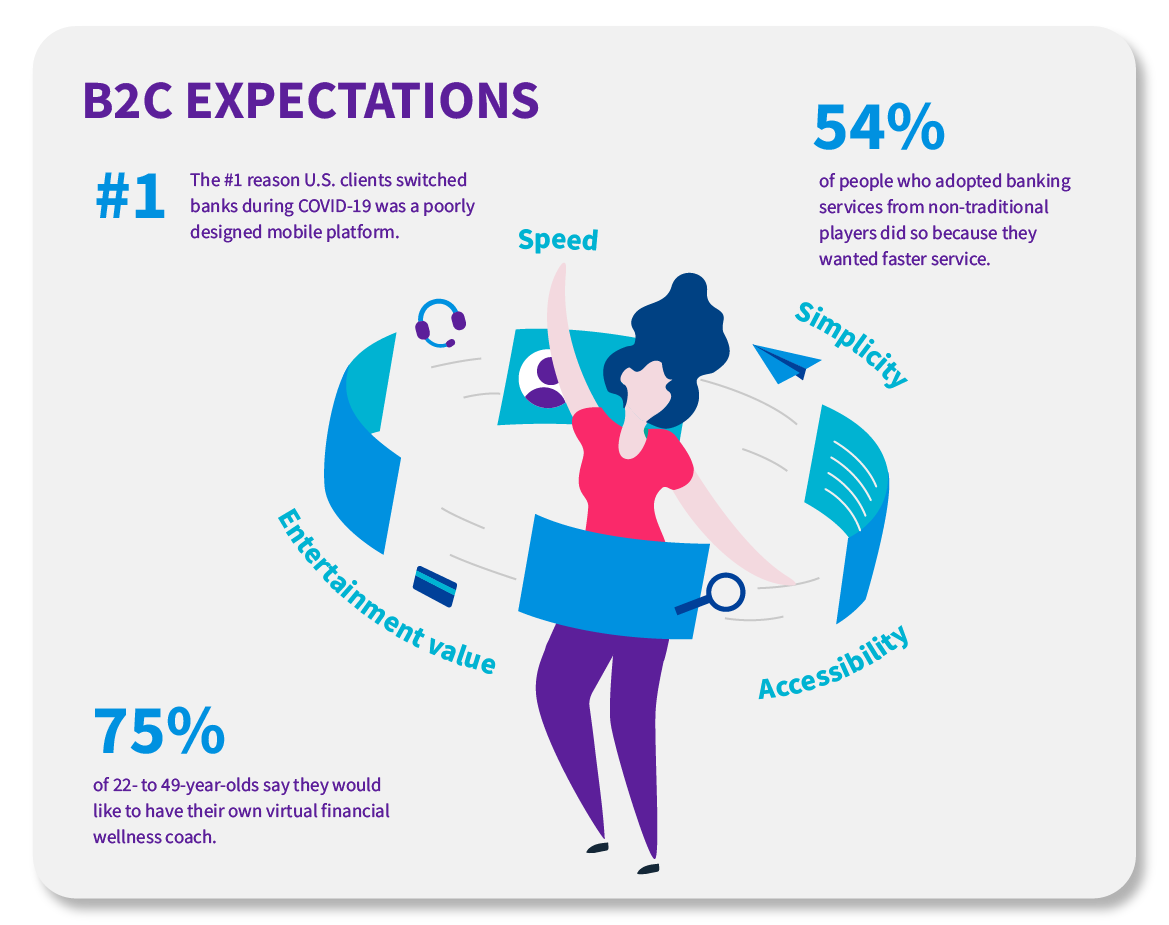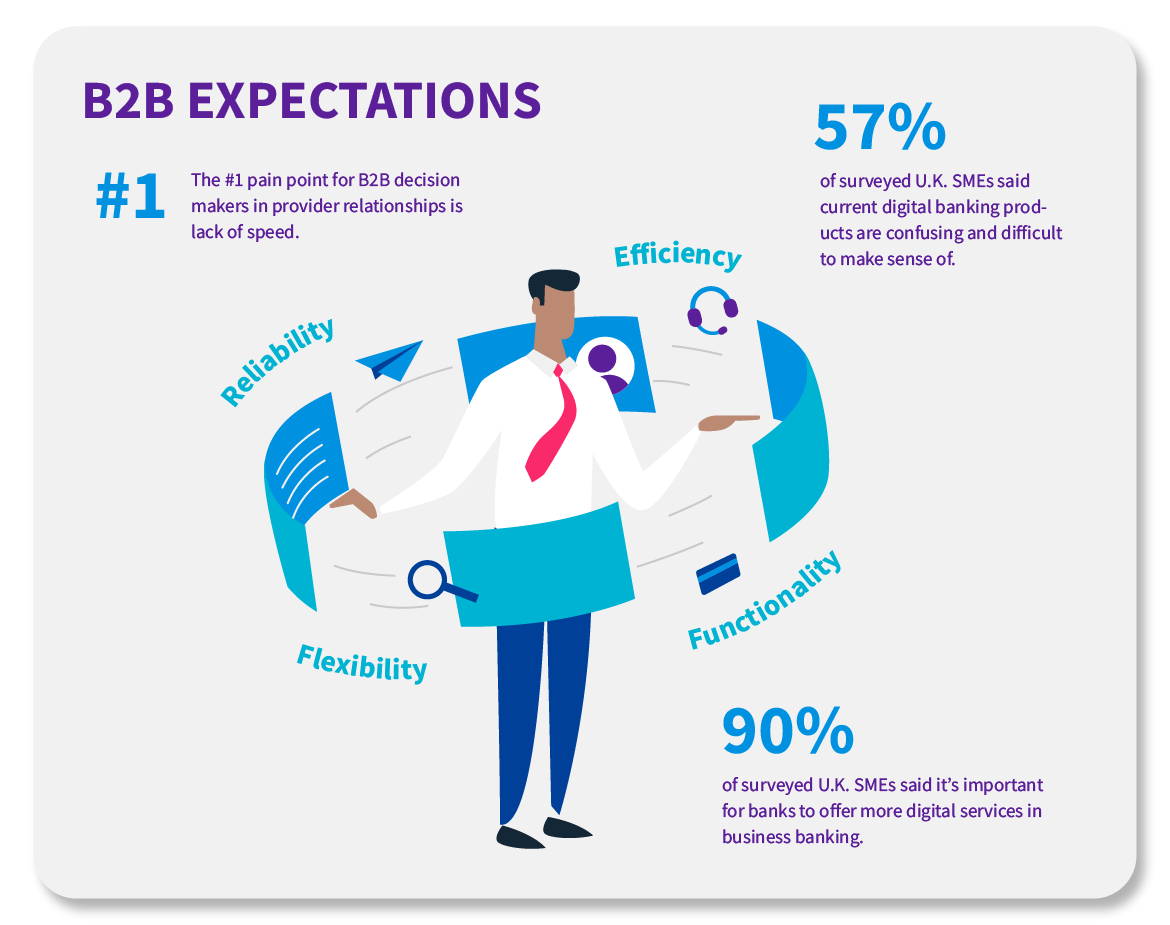A company’s customer service is perhaps the most telling part of its reputation. If the customer experience (CX) is user-centric, streamlined, and constantly updated to meet new expectations, it’s easy to see that the company cares about the people it serves. If, on the other hand, service is unreliable and frustrating, customers may feel they’re being treated as numbers on a page — only valuable when they’re generating immediate value.
This is especially true in the financial industry. Banks and other organizations must answer time-sensitive questions, explain complex banking processes, and help customers navigate potentially stressful situations regarding their private or business finances. Luckily, there’s a simple way to make these tasks more manageable: offering self service solutions.
Here’s what you need to know about self service banking: what it is, how it’s viewed by business-to-consumer (B2C) and business-to-business (B2B) clients, and which technical capabilities make it possible.
A Look at Self Service Banking
Self service has a long history in banking. One of the earliest and most important examples is the introduction of the ATM, which appeared for the first time on June 27, 1967. Although this first ATM was located in London, the rest of the world quickly followed suit; for example, the first ATMs appeared in the U.S. in 1969 and in China in 1985. This represented an important development for financial institutions: Customers no longer had to visit tellers or even their local bank branch to withdraw cash.
In many ways, the introduction of the ATM set the stage for an entirely new approach to banking. Although clients wouldn’t begin to expect full self service experiences until the internet popularized the “do it yourself” approach to many tasks, this early innovation signifies that consumers have long been interested in managing their own banking needs.
This explains where the concept of self service banking may have come from, but why are so many financial institutions still pursuing it today? Here’s a look at the “why” behind this approach:
Meeting Customer Expectations
Modern customers want the convenience of completing key financial tasks on their own time. Just as importantly, today’s consumers expect these tasks to connect seamlessly to in-branch interactions, creating a truly omnichannel banking experience. This is an important consideration for financial institutions, as positive customer experiences build loyalty and increase return on investment (ROI).
Creating a Competitive Edge

A 30% increase in conversions, a 30% rise in customer registrations — these are just two examples of how self service can help give financial institutions a competitive edge. If a client wants self service across multiple channels, they’re far more likely to choose a bank that respects their time by offering these options.
Empowering Service Representatives
Reducing the burden on service representatives allows them to focus on higher-value business opportunities. This empowers them to help drive more revenue, expand on their talents and support company goals in broader, more dynamic ways.
Reducing Costs
Digital self service can improve CX while minimizing costs — for example, by minimizing call volume to customer support centers. Driving more traffic to online touchpoints helps reduce cost-to-serve by letting consumers personalize their own experiences instead of making customer service representatives into “middle men.”
Self Service Banking for B2C Customers
Although it’s key to understand the history and value of self service banking, it’s equally important to appreciate the customer’s perspective. Let's look at this functionality from the viewpoint of B2C clients.

Sources: What Does Personalization in Banking Really Mean?, Digital banking redefined in 2021, World Fintech Report 2020
- Simplicity: Customers are looking for products and services that make their lives easier. When offered effectively, self service does just that.
- Entertainment value: As attention spans get shorter, B2C clients are increasingly interested in interactions that offer more value than just marking things off their to-do list. They want entertainment, promotions, and unique experiences — all of which can be attained through self service tasks.
- Accessibility: These days, mobile access is more important than ever. Self service tasks are easy to perform on mobile, which means customers can bring their banks with them wherever they go.
- Speed: B2C clients appreciate fast service. Luckily, self service provides for this demand by allowing users to complete tasks entirely at their own pace.
Self Service Banking for B2B Customers
Every individual brings unique preferences and expectations to banking interactions, but B2B customers are, in some ways, different from their B2C counterparts. That’s because B2B clients depend on financial institutions to help support and structure their own businesses, creating the opportunity for a deeper partnership.
That being said, even the best partnership doesn’t require constant person-to-person interaction. Instead, these customers need self service banking options to help streamline and simplify their B2B financial experience.

Sources: Finding the right digital balance in B2B customer experience, SMEs ‘More Reliant Than Ever’ on Digital Services in Wake of COVID-19
- Reliability: Customer relationships are more complex in B2B scenarios. These clients want to know they can count on their bank whenever and wherever they need — something self service can help prove.
- Efficiency: B2B clients are especially protective of their time, since every minute they spend on banking services takes away from their own ability to serve customers and deliver top-notch products. Self service provides the necessary efficiency by allowing B2B customers to complete tasks without waiting for help from a service representative.
- Functionality: In the B2B space, it’s critical to have access to digital tools and modern functionality. COVID-19 forced commercial banks to innovate with solutions like self service, showing B2B clients they’re ready and willing to adapt to new demands.
- Flexibility: When working with B2B clientele, multiple people may be using the same customer account with different roles in the business. Commercial banks need the flexibility to tailor tasks, touchpoints, and processes to individual customer needs.
How to Provide Key Self Service Capabilities
It’s clear that self service is incredibly important for B2B and B2C customers alike, not to mention the banks that serve them. To take advantage of these benefits, financial institutions need a simple, effective way to deliver self service capabilities — and the answer is often a self service customer portal.
These portals act as a platform for key features, functions, and tools, giving banking customers a single touchpoint for all self service interactions. Here’s what a portal should look like:
Support for Different Task Types
Self service shouldn’t be limited to only a few kinds of tasks. Instead, a portal should allow customers to:
-
Find product and service information personalized to their needs.
-
Complete onboarding digitally without having to visit a bank branch.
-
Update personal information without disclosing sensitive details over the phone or email.
-
Access sensitive data through a secure online connection.
-
Apply for loans independently.
-
Do everything in one place through a single URL instead of multiple logins and websites.
Experience Management
Banks need to empower non-technical users to easily create, manage, and personalize rich digital experiences without the help of IT teams. A self service portal should offer low-code or no-code functionality to make this possible, allowing users of all backgrounds to create pages and layouts without IT input. Tools like audience segmentation, personalization, and content recommendations help further manage customer experience, making every interaction both valuable and enjoyable.
User Management and Data Privacy
B2B and B2C customers alike need to know their data is protected. For example, self service account management allows clients of both kinds to update information themselves instead of sharing this sensitive data so a representative can make updates for them. Similarly, B2B customers can create roles for each individual who interacts with the portal, controlling access through permissions so the right tasks are accessible to the right people.
Powerful Search Capabilities
One key part of self service banking is a company knowledge base, which can be connected to chatbots and search tools. This allows customers to find articles, how-to videos, and more, all by using their own search terms and browsing personalized results. To make these things possible, a customer portal should offer powerful out-of-the-box search capabilities supported by knowledge base management tools and other solutions. The result is a single solution that improves CX while reducing cost-to-serve.
Software Integration
Banks often struggle to provide all services in one place because they have multiple systems for each different business unit. Acquisitions multiply the issue, forcing banks to juggle different systems for core services, business process management (BPM), Authentication (AuthN) and Authorization (AuthZ), and more.
A portal that sits on top of these solutions, integrating rather than replacing them, allows banks to simplify the digital transformation process. It also allows the connection of a customer’s preferred channels, including mobile apps, chatbots, and kiosks — all from a single source.
Effective Cross-Selling Features
Part of self service — and, in fact, CX overall — is offering the right message at the right time. Although cross-selling is an important tool when interacting with both B2B and B2C customers, it’s important for financial institutions to understand when and how to leverage these opportunities depending on the user, their unique banking needs, and their original intentions.
For example, say a B2C customer has logged onto the self service portal to complete an urgent task. At this point, cross-selling attempts would be distracting and perhaps even frustrating. However, this customer may be more perceptive after the task is completed, especially if the offered product or service is tailored to their profile or previous browsing behavior. The same is true for B2B clients: If a customer is involved in manufacturing, you can offer them financing options for new equipment and machines, helping expand your relationship while providing real value.
Self Service for B2B and B2C Banking Customers
Self service is, in many ways, the future of banking. It addresses fast-moving client expectations by putting them in charge of their own experiences, creating benefits for both the client and the financial institution. Although the value of self service is seen differently by B2B and B2C customers, it’s clear that this solution can address every banking customer’s unique needs.
Perhaps most importantly, self service eliminates the need to choose between cost-effective and excellent CX. By reducing cost-to-serve, freeing up employees to focus on high-value business opportunities, and building better client relationships, self service adds a rich new dimension to CX.
All of this is made possible through a flexible, powerful self service portal like Liferay’s Digital Experience Platform. To see how it supports financial institutions and their B2B and B2C customers, schedule a demo today.
See how you can build a solution fit for your needs
Diamond Bar, CA 91765
USA
+1-877-LIFERAY


